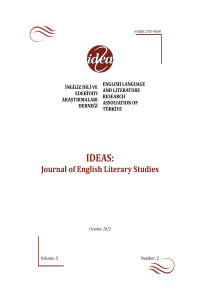“Presume not that I am the thing I was”: The Transformation of the Idea of the King and the Concept of Kingship in Shakespeare’s Henriad
Öz
From 1584 to 1599, Shakespeare wrote two tetralogies of history plays covering the period from the reign of Richard II to Henry VII. As Elizabeth’s age (she was fifty-seven in 1590), her problematic right to the crown, and the fact that the crown would pass to the Stuart dynasty, whose Catholic members had previously been excluded as potential successors, unless the queen would leave an heir make history plays popular among the theatregoers in Shakespeare’s time. In his history plays, Shakespeare is concerned with the problems of rebellion, the divine right of kings, and the nature of kingship. In his portrayal of kings, the playwright is more concerned with the monarchs’ actions rather than their eloquent speeches. The king in each play, as well as several other characters, provides insight and embodies a different approach to the idea of an ideal monarch. Each king differs from the other in crucial ways and has unique weaknesses and strengths. The hardships of being a king and the responsibility it brings are central to these plays, and the soliloquies delivered by the characters draw attention to what actually makes a king or gives him the right to rule, a question that has been considered at key points throughout the sequence of the history plays. Hence, this paper aims to scrutinize the transformation of the idea of a king and the concept of kingship in Shakespeare’s Henriad, namely Richard II, Henry IV Part 1, Henry IV Part 2, and Henry V.
Anahtar Kelimeler
Shakespeare History Plays Henriad Concept of Kingship Henry V
Kaynakça
- Bloom, Harold. Shakespeare: The Invention of the Human. Riverhead, 1998.
- Carroll, William C. “Theories of Kingship in Shakespeare’s England.” A Companion to Shakespeare’s Works, Volume II: The Histories. Edited by Richard Dutton and Jean E. Howard, Blackwell, 2003, pp. 125–145.
- Crewe, Jonathan. “Henry IV, Part 2: A Critical History.” A Companion to Shakespeare’s Works, Volume II: The Histories. Edited by Richard Dutton and Jean E. Howard, Blackwell, 2003, pp. 432–450.
- Hadfield, Andrew. “Henry V.” A Companion to Shakespeare’s Works, Volume II: The Histories. Edited by Richard Dutton and Jean E. Howard, Blackwell, 2003, pp. 451–467.
- Heims, Neil. Bloom’s How to Write about Shakespeare’s Histories. Chelsea House, 2010.
- Hopkins, Lisa. “The King’s Melting Body: Richard II.” A Companion to Shakespeare’s Works, Volume II: The Histories. Edited by Richard Dutton and Jean E. Howard, Blackwell, 2003, pp. 395–411.
- Knowles, James. “Henry IV.” A Companion to Shakespeare’s Works, Volume II: The Histories. Edited by Richard Dutton and Jean E. Howard, Blackwell, 2003, pp. 412–431.
- Machiavelli, Niccolò. The Prince. Translated by C. E. Detmold, Wordsworth, 1997.
- Shakespeare, William. The Arden Shakespeare Complete Works. Edited by Richard Proudfoot et al. The Arden Shakespeare, 2021.
Öz
Kaynakça
- Bloom, Harold. Shakespeare: The Invention of the Human. Riverhead, 1998.
- Carroll, William C. “Theories of Kingship in Shakespeare’s England.” A Companion to Shakespeare’s Works, Volume II: The Histories. Edited by Richard Dutton and Jean E. Howard, Blackwell, 2003, pp. 125–145.
- Crewe, Jonathan. “Henry IV, Part 2: A Critical History.” A Companion to Shakespeare’s Works, Volume II: The Histories. Edited by Richard Dutton and Jean E. Howard, Blackwell, 2003, pp. 432–450.
- Hadfield, Andrew. “Henry V.” A Companion to Shakespeare’s Works, Volume II: The Histories. Edited by Richard Dutton and Jean E. Howard, Blackwell, 2003, pp. 451–467.
- Heims, Neil. Bloom’s How to Write about Shakespeare’s Histories. Chelsea House, 2010.
- Hopkins, Lisa. “The King’s Melting Body: Richard II.” A Companion to Shakespeare’s Works, Volume II: The Histories. Edited by Richard Dutton and Jean E. Howard, Blackwell, 2003, pp. 395–411.
- Knowles, James. “Henry IV.” A Companion to Shakespeare’s Works, Volume II: The Histories. Edited by Richard Dutton and Jean E. Howard, Blackwell, 2003, pp. 412–431.
- Machiavelli, Niccolò. The Prince. Translated by C. E. Detmold, Wordsworth, 1997.
- Shakespeare, William. The Arden Shakespeare Complete Works. Edited by Richard Proudfoot et al. The Arden Shakespeare, 2021.
Ayrıntılar
| Birincil Dil | İngilizce |
|---|---|
| Konular | Edebi Çalışmalar, Sanat ve Edebiyat, Uygulamalı Tiyatro |
| Bölüm | Research Articles |
| Yazarlar | |
| Erken Görünüm Tarihi | 31 Ekim 2023 |
| Yayımlanma Tarihi | 31 Ekim 2023 |
| Gönderilme Tarihi | 27 Temmuz 2022 |
| Yayımlandığı Sayı | Yıl 2023 Cilt: 3 Sayı: 2 |
IDEAS: Journal of English Literary Studies is published by The English Language and Literature Research Association of Türkiye (IDEA).


